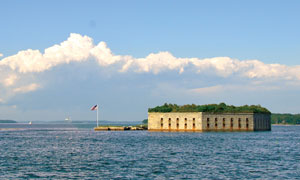April 2016 | view this story as a .pdf
Fort Gorges was modeled on Fort Sumter. What a wild duet.
By Colin W. Sargent
 On the Endangered List: the crown jewel of Portland Harbor, Fort Gorges, “modeled after Fort Sumter in Charleston, South Carolina,” according to Greater Portland Landmarks. What a difference a little geography makes.
On the Endangered List: the crown jewel of Portland Harbor, Fort Gorges, “modeled after Fort Sumter in Charleston, South Carolina,” according to Greater Portland Landmarks. What a difference a little geography makes.
Consider the resumes of the two look-a-like forts. The Civil War actually started at Fort Sumter. In Charleston Harbor, the Union was coming apart at the seams. On December 20, 1860, Union army major Robert Anderson had no choice but to relocate his command of 85 soldiers from Fort Moultrie on Sullivan’s Island to Fort Sumter in the center of the harbor to guarantee their safety. The view was extraordinary, but they were stuck out there for months, with dwindling supplies. According to Civilwar.org, “Just after the inauguration of President Abraham Lincoln on March 4, 1861, Anderson reported that he had only a six-week supply of food left in the fort and Confederate patience for a foreign force in its territory was wearing thin.”
Something had to give.
“On Thursday, April 11, 1861, Confederate Brig. Gen. P.G.T. Beauregard dispatched aides to Maj. Anderson to demand the fort’s surrender. Anderson [who had once taught Beauregard at West Point] refused. The next morning, at 4:30 a.m., Confederate batteries opened fire on Fort Sumter and continued for 34 hours. The Civil War had begun!”
Fort Sumpter earned acting credits in the movie Glory (though history buffs delight in pointing out that Hollywood put the Atlantic Ocean on the wrong side of the camera). Consider this comment: “Just pulled Glory off the shelf and watched it this week. After pulling out the maps, I was confused about the movie’s orientation of the siege. Hollywood, why did you mess this up!? Why didn’t they just cut and flip that part of the film reel? I was so frustrated, I actually pulled a long mirror out of my closet and set it up to watch the siege in the correct direction. Much more realistic.” (Would the selfie he likely snapped while doing this have undone the effect?)
Which makes the strikingly silent career of Fort Gorges, Fort Sumter’s northern counterpart, all the more extraordinary. Built of granite (Sumter is brick) from 1859 to 1865 and attacked only by gulls, Fort Gorges is “the still center of the spinning world.” After World War II, Navy submarine cables were stored inside without fanfare. Spectacularly, nothing continued to happen after that. In 1960, the government gave up the ghost and deeded it to the City of Portland, which continues to own it today.
With time its only enemy, here’s the assessment as Landmarks sees it: “Threat: Rapid Property Deterioration Fort Gorges has become overgrown with vegetation and shows signs of masonry deterioration. Lack of maintenance and investment in masonry repair, lack of a long-term preservation plan, and its location in a harsh marine environment battered by wind and weather, will continue to compromise the structural integrity of the brick and granite masonry and overall preservation of the structure. While citizens have shown some initial interest in forming a Friends of Fort Gorges group, the scale, lack of access, and large financial needs of the fort create tremendous challenges to its preservation.”
Earlier this year, the City of Portland announced a “public/private partnership” with the Army Corps of Engineers and the non-profit Friends of Fort Gorges. The Army Corps will begin “hazard mitigation” on the site this year, using federal funds available for the purpose of restoring former defense sites. And the Maine Historic Preservation Commission has given the city a $20,000 grant to fund a master plan for future work.
Maybe after all, Fort Gorges is our good-luck charm. The best forts are those where re-enactors don’t get to do anything but play solitaire.






0 Comments